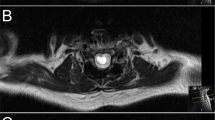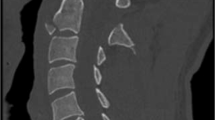Abstract
Traumatic spinal cord injury (SCI) is a major cause of severe and permanent disability in young adults. Overweight and obesity are commonly observed among patients affected with SCI, with reports of a prevalence of over 60 and 30% respectively. Case report: A 34 year-old woman suffering from tetraplegia after sustaining a traumatic injury to C5-C6 at age 23 as a result of a motor vehicle accident was presented to our hospital’s multidisciplinary bariatric team due to class II obesity. At the time of presentation to the team, eleven years after the accident, her BMI was calculated to be 39 Kg/m2 (weight 97 kg, height 1.57 meters). She was diagnosed with infertility while seeking pregnancy, and referred to our bariatric unit for weight loss. In addition, she had overcome the physical limitations of her injury, had a regular job and was engaged in regular physical activities such as swimming. In May 2017, she underwent laparoscopic sleeve gastrectomy (LSG) without complications and was discharged on postoperative day 2. 17 months following LSG, with a normal BMI, she became naturally pregnant. She had emergency cesarean at 35 weeks due to pneumonia but both patient and child recovered without sequelae. Currently, 4 years after surgery she maintains 37.11% total weight loss (weight 61 kg). She reports having a better quality of life with fewer medical intercurrencies. Conclusions: Patients with SCI and obesity, particularly women seeking to conceive, may be benefited by being referred to bariatric teams for assessment and treatment to improve results associated with sustained weight reduction.
This is a preview of subscription content, access via your institution
Access options
Subscribe to this journal
Receive 1 print issues and online access
We are sorry, but there is no personal subscription option available for your country.
Buy this article
- Purchase on Springer Link
- Instant access to full article PDF
Prices may be subject to local taxes which are calculated during checkout
Similar content being viewed by others
References
Braguinsky J. Obesity prevalence in Latin America. Sist Sanit Navar. 2002;25:109–15.
Cardone A, Borracci RA, Milin E. Estimación a largo plazo de la prevalencia de obesidad en la Argentina. Rev Argent de Cardiolía. 2010;78:23–9.
Del Busto JEB, González EH, Reinaldo MP, Suárez FA, Pérez FZ. Caracterización clínica de pacientes con lesión medular traumática. Rev Mex Neurosci. 2002;3:135–42.
Gupta N, White KT, Sandford PR. Body mass index in spinal cord injury – a retrospective study. Spinal Cord. 2006;44:92–4.
Rajan S, McNeely MJ, Warms C, Goldstein B. Clinical assessment and management of obesity in individuals with spinal cord injury: a review. J Spinal Cord Med. 2008;31:361–72.
Dag ZO, Dilbaz B. Impact of obesity on infertility in women. J Turkish Ger Gynecol Assoc. 2015;16:111–7.
Casimiro I, Sam S, Brady MJ. Endocrine implications of bariatric surgery: a review on the intersection between incretins, bone, and sex hormones. Physiol Rep. 2019;7:e14111.
Gambineri A, on behalf of the Obesity Programs of nutrition, Education, Research and Assessment (OPERA) group, Laudisio D, Marocco C, Radellini S, Colao A, et al. Female infertility: which role for obesity? Int J Obes Suppl. 2019;9:65–72.
Clark AM, Thornley B, Tomlinson L, Galletley C, Norman RJ. Weight loss in obese infertile women results in improvement in reproductive outcome for all forms of fertility treatment. Hum Reprod. 1998;13:1502–5.
Sim KA, Dezarnaulds GM, Denyer GS, Skilton MR, Caterson ID. Weight loss improves reproductive outcomes in obese women undergoing fertility treatment: a randomized controlled trial. Clin Obes. 2014;4:61–8.
Cantay H, Binnetoglu K, Erdogdu UE, Firat YD, Cayci HM. Comparison of short- and long-term outcomes of bariatric surgery methods: A retrospective study. Med (Baltim). 2022;101:e30679.
Tetreault L, Kopjar B, Nouri A, Arnold P, Barbagallo G, Bartels R, et al. The modified Japanese Orthopaedic Association scale: establishing criteria for mild, moderate and severe impairment in patients with degenerative cervical myelopathy. Eur Spine J. 2017;26:78–84.
American Spinal Injury Association. Worksheet International standards for neurological classification of spinal cord injury (ISNCSCI); Revised version November 2015.
Froehlich-Grobe K, Lollar D. Obesity and disability: time to act. Am J Prev Med. 2011;41:541–5. https://doi.org/10.1016/j.amepre.2011.07.015.
DeForge D, Blackmer J, Garritty C. Fertility following spinal cord injury: a systematic review. Spinal Cord. 2005;43:693–703.
Dawood R, Altanis E, Ribes-Pastor P, Ashworth F. Pregnancy and spinal cord injury. Obstet Gynaecol. 2014;16:99–107.
Shojaei MH, Alavinia SM, Craven BC. Management of obesity after spinal cord injury: a systematic review. J Spinal Cord Med. 2017;40:783–94.
Alaedeen D, Jasper J. Gastric Bypass Surgery in a Paraplegic Morbidly Obese Patient. Obes Surg. 2006;16:1107–8.
Author information
Authors and Affiliations
Contributions
FAC, VMCB, and FGW drafted the manuscript. VMCB, AFB, SG, and FGW supervised the writing of the manuscript. FGW performed perioperative management and operation of the patient. All authors read and approved the final manuscript.
Corresponding author
Ethics declarations
Competing interests
The authors declare no competing interests.
Additional information
Publisher’s note Springer Nature remains neutral with regard to jurisdictional claims in published maps and institutional affiliations.
Rights and permissions
Springer Nature or its licensor (e.g. a society or other partner) holds exclusive rights to this article under a publishing agreement with the author(s) or other rightsholder(s); author self-archiving of the accepted manuscript version of this article is solely governed by the terms of such publishing agreement and applicable law.
About this article
Cite this article
Corvatta, F.A., Cano Busnelli, V.M., Beskow, A.F. et al. Sleeve gastrectomy as a bridge to maternity in a patient with obesity, infertility and tetraplegia. A case report. Spinal Cord Ser Cases 10, 2 (2024). https://doi.org/10.1038/s41394-024-00614-9
Received:
Revised:
Accepted:
Published:
DOI: https://doi.org/10.1038/s41394-024-00614-9



